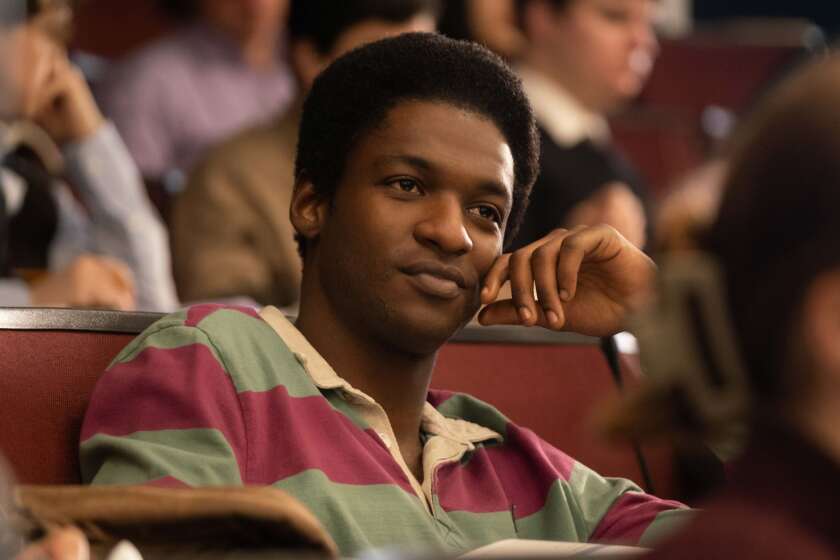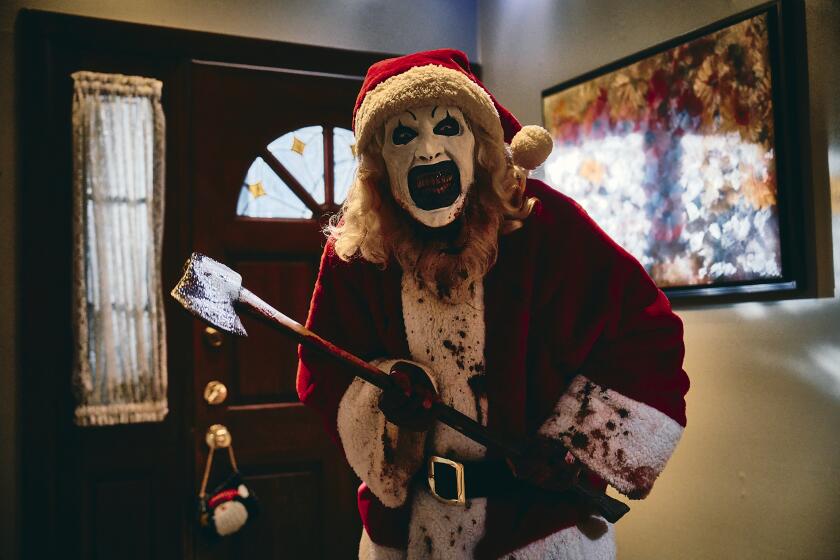MOVIE REVIEW : A Stunning ‘Silence’ : Jodie Foster’s FBI trainee is pitted against Anthony Hopkins’ insane, evil psychiatrist in Jonathan Demme’s suspenseful ‘The Silence of the Lambs.’
The Jonathan Demme of “Something Wild” or “Melvin and Howard’ or “Stop Making Sense” might not be the first director one would think of for suspense or bloody terror; his touch has always seemed lighter, his interests more quirky and off the mainstream. So much for pigeonholing. Demme’s vision of “The Silence of the Lambs,” Thomas Harris’ truly terrifying novel, is stunning. It is also unusual--as the FBI races to save a kidnaped young woman from a serial killer, Demme concentrates on the hypnotic duel between his two strong central characters, an FBI trainee and a brilliant sociopath, rather than on easy effects calculated to make an audience jump.
They may jump anyway, since “The Silence of the Lambs” (Thursday at selected theaters) is marked by the second appearance of Dr. Hannibal Lecter--Hannibal the Cannibal--and Anthony Hopkins’ insinuating performance puts him right up there with the screen’s great bogymen.
We have seen Dr. Lecter’s pure evil before: the imprisoned insane psychiatrist/murderer was played mesmerizingly by Brian Cox in “Manhunter,” Michael Mann’s adaptation of Harris’ earlier novel “Red Dragon.” Later, perhaps realizing the pull of the monster he created, Harris moved Lecter to the forefront of “Lambs,” and here in Ted Tally’s screenplay he very nearly owns the film. Only nearly--he would have to be superhuman to wrest this film away from Jodie Foster, and Lecter is only super-deviant.
Foster’s Clarice Starling is a promising FBI trainee in her last year, brought in by Jack Crawford (Scott Glenn), chief of the Bureau’s Behavioral Science Section, to do a psychological profile of Lecter. Although Starling isn’t let in on the bureau’s full agenda, Crawford’s hope is that Lecter can be lured into shedding light on one of his own kind, a seemingly random serial killer nicknamed Buffalo Bill who flays the bodies of his women victims for his own, unfathomable purposes.
The build-up to Starling’s first meeting with Lecter is as dramatic as the unmasking of the Phantom of the Opera. Warned not to tell him anything personal--”You don’t want Lecter inside your head”--the list of things Starling may not do, touch or say is capped by a photograph of Lecter’s last victim, a nurse within the asylum whose grisly fate is graphically told and shown to Starling.
Mercifully, Demme doesn’t share this sight with us, although there will be a gruesomely clinical tour of one of Buffalo Bill’s victims in a later scene. The film is MPAA-rated R for explicit shots of the murder victims, for terror, for scenes of gore and violence and for language.
The film swings between Starling and Lecter as though it were moving between sunlight and the chill of fluorescence. Even within the straitjacket of FBI-approved behavior, Foster radiates intelligence, sturdiness, unspoken empathy with the poor dead victims and the most profound human concern.
Hopkins, sometimes literally straitjacketed, exudes cunning, a laser-keen intellect, patent contempt for most of the world, concentration that could seemingly bend spoons and terrifying physical power. Lecter’s persuasiveness becomes particularly threatening when he agrees to trade insights on Buffalo Bill for details of Starling’s past, and from these he forges an unsettling bond with her.
Our fears about Lecter are heightened by Kristie Zea’s production design for his isolation cell: its bars are far apart, separated by super-thick glass, but the visual effect deliberately suggests that the glass isn’t there at all, that Lecter could simply reach through the bars to Starling . . . or to us. Demme punches up this immediacy as Hopkins and Foster work directly into cinematographer Tak Fujimoto’s camera in some of these early, intense scenes, a device that propels Lecter’s cajoling, deprecating tirades directly at us.
After Buffalo Bill kidnaps a U.S. senator’s feisty, resourceful daughter (Brooke Smith), Crawford pulls Starling into the hunt as his assistant, liking her insights and her deductions.
Although Demme’s touch with the interplay between Crawford and Starling is deft--Crawford’s terseness belying his concern for her--when Starling takes off on her own to follow a Lecter clue to a long-abandoned storage garage, Demme muffs one of the book’s prime scenes of terror. He seems unwilling to give this scene its full measure of anxiety, letting it unroll without charge or crescendo. More to his liking are the film’s deadpan vignettes of a woman in a male-dominated world, whether it is an FBI Academy elevator or a police examination room in the deep South.
Demme and screenwriter Tally have also done lovely things with the brief flashbacks illuminating Starling’s childhood as the adoring daughter of a small town marshal. Foster’s subtle, intelligent performance takes it from there, filling in the whole woman; Clarice, coloring under Lecter’s cruel mimicry of her almost-buried “rube” accent, flinching at his brutally accurate X-ray of her ambition and her attempt to better herself through the academy.
Hopkins’ performance may be the film’s bravura showpiece, but Foster’s goes the whole distance, steadfast, controlled, heartbreakingly insightful, a fine addition to her gallery of characterizations.
Although Crawford’s search for Buffalo Bill and the Starling/Lecter duel dominate the action, the film is dotted with real, peripheral characters who give it a sense of authenticity: Kasi Lemmons as Starling’s supportive roommate Ardilia; Paul Lazar as the sweetly friendly Smithsonian entomologist; Anthony Heald as Lecter’s prideful jailer, the smarmy Dr. Chilton, and Ted Levine’s terrifying Buffalo Bill, a.k.a. Jame Gumb.
‘The Silence of the Lambs’
Jodie Foster: Clarice Starling
Anthony Hopkins: Dr. Hannibal Lecter
Scott Glenn: Jack Crawford
Ted Levine: Jame Gumb/Buffalo Bill
Anthony Heald: Dr. Frederick Chilton
Kasi Lemmons: Ardilia Mapp
An Orion release of a Strong Heart/Demme production. Producers Edward Saxon, Kenneth Utt, Ron Bozman. Executive producer Gary Goetzman. Director Jonathan Demme. Screenplay Ted Tally based on the novel by Thomas Harris. Camera Tak Fujimoto. Editor Craig McKay. Music Howard Shore. Production design Kristie Zea. Costumes Colleen Atwood. Running time: 1 hour, 58 minutes.
MPAA-rated: R (terror, gore, explicits shots of murder victims, violence and threats of violence, language)
More to Read
Only good movies
Get the Indie Focus newsletter, Mark Olsen's weekly guide to the world of cinema.
You may occasionally receive promotional content from the Los Angeles Times.










